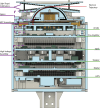Observing Cusp High-Altitude Reconnection and Electrodynamics: The TRACERS Student Rocket
- PMID: 40635973
- PMCID: PMC12234602
- DOI: 10.1007/s11214-025-01192-4
Observing Cusp High-Altitude Reconnection and Electrodynamics: The TRACERS Student Rocket
Abstract
Observing Cusp High-altitude Reconnection and Electrodynamics (OCHRE) is a student/early career researcher (ECR) focused sounding rocket that will fly as a compliment to the TRACERS satellites. OCHRE will utilize the deep institutional knowledge of the TRACERS science team to educate and mentor a team of graduate students and ECRs to serve as instrument leads, project manager, and primary investigator. Aiming for a near conjunction with, and at an apogee above, TRACERS in the northern polar cusp, OCHRE will answer some remaining questions from the TRICE-II sounding rockets using TRACERS to contextualize observations in the larger-scale polar cusp dynamics.
Keywords: Cusp; Sounding rocket; Student; TRACERS.
© The Author(s) 2025.
Conflict of interest statement
Competing InterestsAuthors declare no competing financial or other interests.
Figures













References
-
- André M, Yau A (1997) Theories and observations of ion energization and outflow in the high latitude magnetosphere. Space Sci Rev 80(1):27–48. 10.1023/A:1004921619885
-
- André M, Norqvist P, Vaivads A, Eliasson L, Norberg O, Eriksson AI, Holback B (1994) Transverse ion energization and wave emissions observed by the Freja satellite. Geophys Res Lett 21(17):1915–1918. 10.1029/94GL00699
-
- André M, Norqvist P, Andersson L, Eliasson L, Eriksson AI, Blomberg L, Erlandson RE, Waldemark J (1998) Ion energization mechanisms at 1700 km in the auroral region. J Geophys Res Space Phys 103(A3):4199–4222. 10.1029/97JA00855
-
- Bonnell JW, Ludlam M, Slagle A, Goodrich K, LaBelle JW (2025) The Electric Field Instrument (EFI) for the TRACERS Mission. Space Sci Rev 221
-
- Brambles OJ, Lotko W, Zhang B, Wiltberger M, Lyon J, Strangeway RJ (2011) Magnetosphere Sawtooth oscillations induced by ionospheric outflow. Science 332(6034):1183–1186. 10.1126/science.1202869 - PubMed
Publication types
LinkOut - more resources
Full Text Sources
